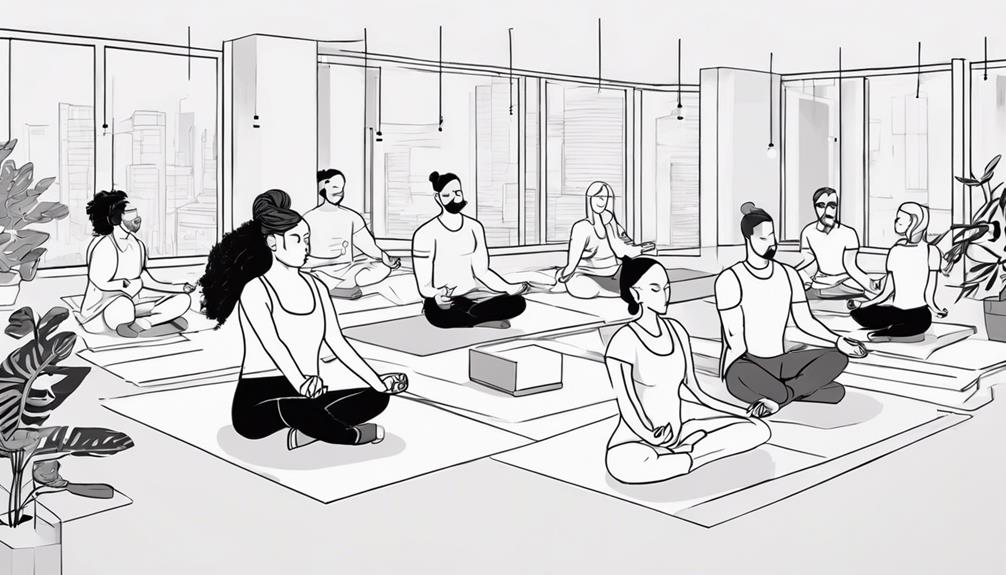You're just minutes away from igniting your life with these short, motivational TED Talks. Discover how inspirational talks from Tom Rives, Amy Purdy, and Elizabeth Gilbert can ignite a spark within you, helping you overcome struggles and reveal your full potential. Explore the beauty of nature, find happiness in unexpected places, and awaken your creative potential. You'll learn to cultivate gratitude, find purpose, and overcome adversity with stories from urban gardening to love letters to strangers. And, get ready to spark positive change in your daily life with simple yet powerful mindfulness practices. The best part? You're just a few minutes away from a life-changing breakthrough – and it's just the beginning.
Key Takeaways
- Inspirational TED talks, like Tom Rives' and Amy Purdy's, can kindle a spark within you and transform your life in minutes.
- A single idea or perspective from a TED talk can overcome struggles and unlock your full potential.
- Elizabeth Gilbert's talk on creativity can inspire new solutions and help you overcome self-doubt and creative blocks.
- Dan Gilbert's insights on happiness can help you find happiness internally and create a fulfilling life.
- Louie Schwartzberg's timelapse photography can cultivate gratitude for nature and inspire a mindful life in just a few minutes.
Transforming Lives in Minutes
In just a few minutes, a single idea or perspective can transform your life, as seen in the powerful talks of Tom Rives, Amy Purdy, Elizabeth Gilbert, Neil Pasricha, and Ron Finley, who've all inspired millions with their remarkable stories.
These motivational speakers have shown us that a brief, yet impactful, message can alter the course of our lives.
Next time, when you're struggling with your life and health, remember that a fresh perspective can be just what you need to turn things around.
Take, for instance, Elizabeth Gilbert's thought-provoking talk on your elusive creative genius. Her words can inspire you to tap into your inner creativity, helping you find new solutions to old problems.
By embracing the power of a single idea, you can break free from limitations and access your full potential.
Nature's Beauty Uncovered

As you open yourself up to the transformative power of a single idea, you're now invited to immerse yourself in the breathtaking beauty of nature, where the intricate details and wonders of the natural world await your discovery.
In Louie Schwartzberg's stunning timelapse photography, you'll witness nature's beauty like never before. His mesmerizing visuals will evoke a sense of wonder, appreciation, and mindfulness towards the natural world.
As you watch, inspiring words from a monk will resonate with you, emphasizing the importance of gratitude in daily life. Schwartzberg's work is a tribute to the ever-changing, awe-inspiring landscapes of our planet. His timelapse footage reveals the intricate details of nature, showcasing the beauty that often goes unnoticed.
As you explore this TED Talk, remember to cultivate gratitude for the world around you. Allow yourself to be enchanted by the beauty of nature, and let it inspire you to live a more mindful, appreciative life.
Happiness in Unexpected Places

You're about to discover that happiness can be found in the most unexpected places, and Dan Gilbert's TED Talk is about to show you how. Gilbert's insights will challenge your conventional thinking, revealing that happiness is not just stumbled upon, but can be synthesized. By choosing experiences wisely, you can create happiness in your life.
| Aspect of Happiness | Conventional Thinking | Gilbert's Insight |
|---|---|---|
| Finding Happiness | Stumbled upon by chance | Can be synthesized through experiences |
| Sources of Happiness | Limited to material possessions | Found in unexpected places and experiences |
| Achieving Happiness | Based on external circumstances | Can be controlled and created internally |
Gilbert's talk will inspire a shift in your perspective, helping you to find happiness in unexpected places. Next time, you'll approach life with a new mindset, focusing on creating happiness through experiences. By applying Gilbert's insights, you'll be on your way to a more fulfilling life, where happiness is within your control.
Unleashing Your Creative Potential

Elizabeth Gilbert's TED Talk, 'Your Elusive Creative Genius,' explores the often-daunting domain of creativity, providing a invigorating perspective on how to overcome the anxieties and self-doubt that can stifle your artistic expression.
As you navigate the world of creativity, you may find yourself constructing barriers to protect your mental health and combat anxiety. Gilbert's talk offers valuable insights on how to overcome these obstacles and tap into your creative potential.
Imagine being able to quiet your inner critic and access your creative brilliance without fear of not meeting past success. Gilbert's talk provides strategies for doing just that, helping you find your unique creative voice and embracing the creative process.
Next time you face a blank page or a creative block, remember that it's normal to struggle. Take a deep breath, and know that you're not alone. In the years to come, prioritize your health and well-being, and your creativity will flourish as a result.
Finding Purpose in Life

Exploring your life's purpose can be a challenging task, especially when feeling lost or stuck in a rut, but with the right mindset and inspiration, you can break free from the monotony and forge a path that truly resonates with your passions and values.
Next time you're feeling uncertain, turn to inspirational TED talks that will kindle a spark within you. Amy Purdy's courageous story of overcoming amputation will show you that limitations don't define you. Alternatively, Elizabeth Gilbert's talk on creative genius will help you tap into your inner source of inspiration.
If you're feeling drained, Neil Pasricha's secrets to a happy life will uplift you in unexpected ways. Ron Finley's urban gardening revolution will inspire you to create change from the ground up. And if you're feeling lonely, Eric Whitacre's virtual choir will remind you of the beauty of connection.
These real secrets to finding purpose in life will help you discover your true calling. So, take a few minutes to watch these motivational TED talks, and get ready to unleash your true potential.
Overcoming Adversity With Gratitude

As you navigate life's challenges, embracing gratitude can be a powerful proof of antidote to adversity, and these inspiring TED talks will show you how.
At a time when it's easy to get bogged down, it's crucial to focus on the good things in life. Amy Purdy's TED talk is a remarkable illustration of this. Despite losing her legs, she refuses to let her disability define her, declaring 'My legs haven't disabled me.' Her story is a demonstration of the impact gratitude can have on our outlook.
Similarly, Hannah Brencher's initiative of writing love letters to strangers showcases the profound impact of small acts of kindness.
In the next few minutes, you'll discover how Louie Schwartzberg's breathtaking timelapse photography, accompanied by words on gratitude, highlights the beauty of nature and reasons to be grateful.
Sparking Positive Change Daily

As you start sparking positive change daily, remember that small wins matter, and it's the accumulation of these tiny victories that ultimately leads to significant transformations.
By incorporating daily mindful moments into your routine, you'll become more aware of your thoughts, emotions, and actions, allowing you to make conscious choices that align with your values and goals.
Small Wins Matter
Recognizing and celebrating your daily small wins is crucial in sparking a chain reaction of positive change that can have a profound impact on your life. Acknowledging that small accomplishments, regardless of how insignificant they may seem, can boost your motivation and create a sense of achievement.
This, in turn, can lead to increased productivity, improved self-esteem, and a more satisfying life.
Here are a few reasons why small wins matter:
- Celebrating small victories can build momentum towards larger achievements, helping you stay motivated and focused on your goals.
- Recognizing small accomplishments can improve your self-esteem and overall satisfaction with life.
- Setting achievable goals and celebrating progress, no matter how small, can help you maintain a positive mindset and stay committed to your objectives.
- Small wins serve as stepping stones towards bigger success, helping you stay motivated and driven to achieve your dreams.
Daily Mindful Moments
What if you could spark positive change in your daily life with just a few mindful moments each day? You can, with Daily Mindful Moments, a series of short motivational TED Talks designed to inspire and empower you. These talks offer practical insights and strategies to cultivate mindfulness, gratitude, and resilience, helping you navigate life's challenges with confidence.
| Mindful Moment | Duration | Benefits |
|---|---|---|
| Morning Meditation | 5 minutes | Reduces stress, increases focus |
| Walking Meeting | 30 minutes | Boosts creativity, improves mood |
| One-on-One Meeting Reflection | 10 minutes | Enhances self-awareness, clarifies goals |
Living a Life of Resilience

As you commence on this journey of building inner strength, remember that resilience isn't about being immune to challenges, but about learning to navigate them.
You'll discover that overcoming adversity together isn't only possible, but also a powerful catalyst for growth.
Building Inner Strength
You're about to discover how building inner strength can be the key to unlocking a life of resilience, where obstacles become opportunities for growth and transformation. By embracing adversity, you can turn it into a stepping stone for personal growth and self-discovery.
As you walk through life's challenges, remember to find your flow while you walk, embracing each step as a chance to learn and grow. Developing inner strength is crucial, just like writing love letters to yourself, reminding yourself of your worth and capabilities.
Here are some insightful takeaways to help you build inner strength:
- Embrace adversity as an opportunity for growth and transformation
- Focus on personal growth and resilience as vital components of a fulfilling life
- Develop strategies to overcome challenges and setbacks
- Cultivate inner strength by embracing your worth and capabilities
Overcoming Adversity Together
When adversity strikes, you're not alone, and it's in these moments that the power of community and connection can help you overcome even the most challenging challenges.
You've likely experienced times when things didn't go as planned, and it felt like the whole world was against you. But next time things don't go your way, remember that people succeed because of their resilience, not in spite of it.
Amy Purdy's remarkable story of overcoming amputation, Ron Finley's grassroots change in South Central LA, and Eric Whitacre's virtual choir of 2,000 voices strong all demonstrate the profound impact on your life that connection and community can have.
Hannah Brencher's Love Letters to Strangers initiative, born from combating depression, highlights the power of reaching out to others when you need it most.
And Louie Schwartzberg's stunning timelapse photography reminds us to find beauty and gratitude even on the most challenging days. These incredible stories show that you don't have to face adversity alone.
Frequently Asked Questions
What Is the Most Inspirational Ted Talk?
As you ponder the most inspirational TED talk, imagine the spark that ignites your passion. You'll find it in Amy Purdy's courageous story, where she defies disability, proving that her legs haven't disabled her spirit, and neither will yours.
What Are the 10 Most Popular TED Talks?
You're looking for the top 10 most popular TED Talks, and you'll find Elizabeth Gilbert, Amy Cuddy, Dan Gilbert, and Brene Brown's talks among them, as well as Tom Thum's beatboxing performance.
How Do You Write a 3 Minute TED Talk?
You're about to craft a TED talk that'll change lives in just 3 minutes – a feat so monumental, it's like moving mountains! To write a compelling talk, focus on a clear narrative, engaging visuals, and practice to guarantee a timely, impactful delivery.
How Long Does It Take to Change Your Life in Ted Talk Summary?
You wonder how long it takes to change your life, and the answer is: it's instant. One profound idea can spark a transformation in a heartbeat, and TED talks prove it, inspiring you to shift your perspective in mere minutes.
Can Spiritual Motivational Speakers Also Provide Short, Life-Changing TED Talks?
Yes, spiritual motivational speakers for calling can absolutely provide short, life-changing TED talks. Their inspirational messages and deep spiritual insights could offer a unique perspective that resonates with a wide audience. Their ability to uplift and encourage others can make a powerful impact in a short amount of time.
Conclusion
As you've witnessed, these short motivational TED talks have the power to awaken the giant within you, just like Michelangelo's David emerged from a block of marble.
Now, it's your turn to tap into your inner strength and resilience. Remember, every great accomplishment begins with a single step, and every storm will pass.
So, take a deep breath, spark positive change, and start living the life you've always imagined – a life that echoes the words of Nelson Mandela, 'The greatest glory in living lies not in never falling, but in rising every time we fall.'










